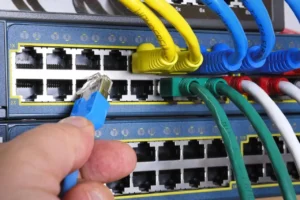Not the worst we’ve ever seen…
People rarely do! For every tidy rack we come across there are fifty that are in a terrible mess. It’s never usually one person’s fault, it’s usually a culmination of a number of factors over a length of time. We’re going to look into the causes of an untidy cabinet and then explain the reasons why it needs sorting ASAP.
Poor Cable Management
Cable management is vital to keeping those cabinets tidy. When you’ve got patch leads and cables running all over the place it’s impossible to see what’s behind them. Switches get hidden, patch panels get hidden and the labels become obstructed. This not only looks untidy, but can cause operational issues when someone starts tugging patch leads out of the way to try to find data switch identification labels and port numbers. In really bad cases they can even unplug the wrong cable entirely!
Cable management bars are the first step in tidying up these situations. Horizontal bars spaced evenly between patch panels and network switches give you a defined route, directing the patch leads to the correct locations and keeping the cables in an orderly fashion so that tracing becomes easier and vital information isn’t obstructed from view.
The next step is cable management in the cabinet itself. Some cabinets don’t allow for patch cables to be routed vertically, so everything just hangs around the front of the cabinet. Again, not just untidy, but unmanageable. It allows cables to tangle easily and of course it obstructs access to the horizontal cable management (if there is any) and the rack mount fixings for patch panels and network switches.
Wrong Length Patch Leads
Patch leads can come in pretty much any length you like. From 0.5 meter to 20 meters and beyond. Patch lead too short? You’ll end up cutting across panels diagonally, missing out cable management routes, stretching cables, stressing connectors and making the whole thing look ugly. Patch lead too long? The excess is going to be stuffed through a gap and hidden somewhere, maybe it’ll just be left on the floor, or maybe it’ll get bunched up and tied up with a cable tie. None of this is ideal. It leads to all kinds of problems and just gets worse with time. The usual problem is a lack of patch leads available to whoever is doing the patching. They pick up the nearest they can find and sling it in. If there was a stock of different length patch leads available they would be more likely to use it. We have seen this first hand. In the tidiest sites we work on there is always a good stock of patch leads, plus a bit of user education.
Lack of Ownership
Leading on from the last point about education. It’s not effective or efficient to have just one person doing all of the patching, particularly in a large organisation. It’s likely that there will be many people in there, patching, moving and adding (rarely removing) equipment. But, someone should take overall ownership of the environments. By appointing an owner of the data cabinets the responsibility is placed with an individual. This individual can then police the cabinets, define a cabling system (we’ll come on to that shortly) and educate any members of staff who don’t understand it, like a new starter for example. Without ownership there won’t be any responsibility to keep the cabinets tidy.
Redundant Equipment
In a lot of untidy data cabinets there is usually a lot of redundant equipment. It’s either left there because nobody wants to deal with it, or because it’s just too difficult to get out with all that messy cabling in the way. The end result is wasted space and more untidy cabling. Space is quite a crucial factor here too. In a lot of cases cable management gets sacrificed to make way for additional equipment, be it servers, switches or more patch panels, and so you end up with more cables and less chance of managing them.
What makes good cable management?

Addressing all of the points above is a good start. Make somebody responsible for the upkeep of the comms cabinets, or the server room as a whole. Trying to trace a patch lead that winds it’s way through a raft of other cables can be frustrating and often leads to it just being unplugged and left there. Implement a colour scheme so that you can easily identify patch leads that are connecting business critical devices. For example, network switch uplinks could be red, server connections could be yellow, user patching could be grey, WiFi access points could be orange and door access control could be pink. It really doesn’t matter what you choose as long as it’s easily identifiable. Stick the colour code on the door of each cabinet so it’s easy to see. That way you won’t get so many mistakenly disconnected servers or access points.
Don’t stack all of your network switches and patch panels on top of each other. Allow at least 1U gap between every two switches/panels for cable management. This is not wasted space! Take some pride in your comms room and keep it tidy.
Remove any redundant cabling and equipment. Don’t leave it there to get in the way. Particularly when repatching users, if the old patch leads are left hanging around they just add bulk to the cabling that’s in there already. Strip it out. Try to have an audit at least once a year where you can identify any redundant cabling and pull it out. It’ll be easier in the long run.
Don’t have time or resources to do this yourself?
That’s where we can help. We’ll help define a colour scheme, supply patch leads, we can even strip the whole thing out and start again if you like? We’ve been doing this a long time, and customers that have listened to our advice have benefited from a much easier to manage and maintain comms rack. It looks nicer too, and that’s something we all like to see.
Contact us on 01908 794 794 or drop us an email to info@litenetuk.com for more information.



